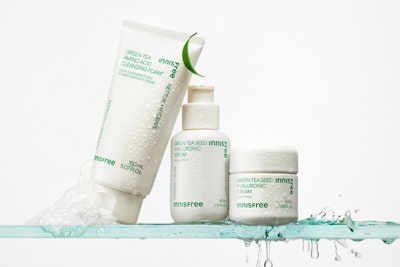innisfree
Affordable South Korean skincare

innisfree's Sustainability Rating
Fair
Ingredients
innisfree and its parent company, Amorepacific Group, have made ingredient commitments to lower its environmental impact, including by avoiding parabens, phthalates, uncertified palm oil or palm oil-derived ingredients, certain harmful suncare ingredients and other petrochemical-based ingredients. While it has made commitments, it still uses some ingredients that pose a significant threat to the climate, including other petrochemical-based ingredients, and homosalate, a harmful suncare ingredient. Its products incorporate bio-based and biodegradable ingredients. It carries products that have certifications from PETA Animal Test-free.
Containers & Packaging
innisfree's parent comapny, Amorepacific Group, has made efforts to minimize the amount of material used in some of its product containers, including by lightweighting. It has made efforts to minimize the volume of material used in its secondary or tertiary shipping packaging. innisfree appears to still rely on plastic packaging, but also uses eco-friendly materials in its product containers and shipping packaging, including ones that are FSC-certified and recyclable.
Energy & Water Use
innisfree's parent company, Amorepacific Group, shares information on its energy strategy. It uses a slight majority of renewable energy to power its production sites and corporate offices. Amorepacific Group has targets for expanding its use of renewable energy. It implements energy efficiency measures in its production sites and corporate offices. It implements water conservation measures, including enhancing the efficiency of ionized water production processes, reducing the amount of wastewater discharged from major facilities, and promoting water recycling. innisfree has a global production span, which is standard for the industry.
Refill & Reuse
innisfree utilizes alternative models for some products to avert waste, including offering a takeback program and refills (though just for one product). Its takeback programs, through TerraCycle and rePurposed at Sephora, allow customers to drop or ship empty containers to be recycled.
Slow Cleaning
innisfree offers frequent releases, which can encourage overconsumption and production of excess inventory.
Marketing
Commons is still evaluating this brand's marketing emails.
Transparency & Reporting
innisfree has a prominent sustainability page with comprehensive details on its climate strategy. It's parent company, Amorepacific Group, publishes a detailed annual report with a clear, impact-driven strategy and progress reporting. Its last annual report was published in 2023. innisfree shares a complete list of ingredients used in its products on a per product basis.
Emissions Tracking
innisfree's parent company, Amorepacific Group, internally measures and publicly reports its company-level emissions in partnership with, or with auditing from, a third party. It includes a breakdown by scope and identifies its top driver of emissions. The last reporting period was 2023. In its most recent update, its estimated emissions footprint was 291,426 tons CO2e.
Targets & Offsets
innisfree's parent company, Amorepacific Group, has SBTi-approved emissions reduction targets for the medium-term (5-10 years) and long-term (10+ years). It has reported on its progress within the past year, and is on track for some of its targets. The parent company offsets scope 1 emissions for some of its operations, though it's unclear what this covers.
Supply Chain & Labor
innisfree's parent company, Amorepacific Group, publishes some information about its supply chain partners, but doesn't provide details on geography or traceability. It publicly shares a supplier code of conduct, which prohibits child labor, includes environmental clauses, ensures the right to collective bargaining, and prohibits forced labor. Its code of conduct doesn't disallow unauthorized subcontracting, ensure a living wage, or establish grievance mechanisms. Amorepacific Group doesn't have a stated policy of regularly auditing its supply chain partners. This may increase human and environmental risks.
Advocacy
innisfree's parent company, Amorepacific Group, discloses all of its trade association memberships, including those that are climate-obstructive. It's a member of 1 large climate-obstructive trade associations: Personal Care Products Council. It isn't a member of advocacy organizations advancing climate policy. It doesn't employ any state lobbyists. Amorepacific Group didn't donate more than $100k to climate-obstructive candidates or PACs from 2018-2024.
innisfree is rated Fair because it has started to improve its ingredients and take responsibility for its emissions, but still has room to improve.
innisfree has committed to avoiding some ingredients that pose a threat to the climate, including parabens, phthalates, other petrochemical-based ingredients, uncertified palm oil or palm oil-derived ingredients, and some harmful suncare ingredients. While it avoids select ingredients, it still uses some that pose a significant threat to the climate, including other petrochemical-based ingredients, and homosalate, a reef-harming suncare ingredient. It still relies on plastic packaging, but it also promotes a takeback partnership with Terracycle to help reduce its packaging waste and emissions footprint.
Its parent company reports using a slight majority of renewable energy in its operations. It shares its emissions measurements and has thorough SBTi-approved emissions reduction targets that are partially on track.
innisfree is owned by Amorepacific Corporation.
Our ratings are based on a scale from 1 (harmful) to 5 (best). How we rate →
https://www.apgroup.com/int/en/commitments/sustainability/sustainability-reports/sustainability-reports.html https://us.innisfree.com/pages/the-innisfree-pledge?srsltid=AfmBOoqVihjAPytOtgUvOA6r6MeUUixw2Etx_Q3-Z11Vy8kOom3goGyf#:~:text=innisfree
https://us.innisfree.com/pages/the-innisfree-pledge?srsltid=AfmBOoqVihjAPytOtgUvOA6r6MeUUixw2Etx_Q3-Z11Vy8kOom3goGyf#:~:text=innisfree
https://au.innisfree.com/pages/better-for-earth?srsltid=AfmBOopkY24xV2EUcO2pTewWI5TdPcrVtYqwv02CTCGxJ056Nc9zAU3u#:~:text=Coral%20Reef
https://www.apgroup.com/int/en/commitments/sustainability/sustainability-reports/__icsFiles/afieldfile/2024/07/04/APG_2023_SR(ENG).pdf
https://us.innisfree.com/pages/the-innisfree-pledge?srsltid=AfmBOoqVihjAPytOtgUvOA6r6MeUUixw2Etx_Q3-Z11Vy8kOom3goGyf#:~:text=innisfree https://au.innisfree.com/pages/better-for-earth
https://au.innisfree.com/pages/better-for-earth
https://us.innisfree.com/pages/the-innisfree-pledge?srsltid=AfmBOoqVihjAPytOtgUvOA6r6MeUUixw2Etx_Q3-Z11Vy8kOom3goGyf#:~:text=innisfree https://us.innisfree.com/pages/the-innisfree-pledge?srsltid=AfmBOoqVihjAPytOtgUvOA6r6MeUUixw2Etx_Q3-Z11Vy8kOom3goGyf#:~:text=We%27re%20taking%20care%20of%20your
https://us.innisfree.com/collections/new
https://us.innisfree.com/pages/the-innisfree-pledge
https://us.innisfree.com/products/green-tea-enzyme-vitamin-c-brightening-cream
https://www.apgroup.com/int/en/commitments/sustainability/sustainability-guidelines-for-amorepacific-partners/sustainability-guidelines-for-amorepacific-partners.html
https://fminus.org/lobbyists/
https://www.fec.gov/data/browse-data/
Get Rewards
Earn for sustainable purchases
Commons rewards you for sustainable purchases from all our Top Rated brands, plus thousands of everyday purchases — from thrift stores to public transit.
Learn more about rewards ->







